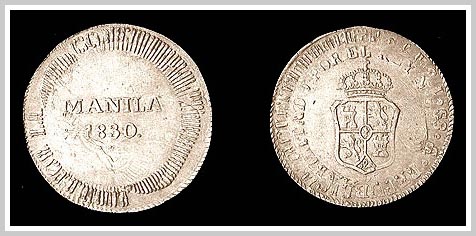| All MANILA
counterstamped coins are avery rare. Among this handful of coins marked
MANILA 1828, 1829 and 1830, the MANILA 1828 is the most numerous, although
by no means common. For reasons yet unknown, there is only ONE known specimen
of the MANILA 1929, an 8-Escudo 1825 Mexico J M in the collection of the
Fabrica Nacional de Moneda y Timbre de Madrid. As the general design of
the MANILA counterstamps soon proved to be unwieldy and impractical, it
has been suggested that this lone MANILA 1829 was struck as a mere formality
-- and almost empty gesture of minimum compliance with the royal decree
requiring it. On the other hand, a continuing study of the MANILA 1830
by one of the few recognized experts in Spanish colonial coinage puts the
scarce number of confirmed specimens around the world at about twenty-five.
The specimen
featured above is a MANILA 1830 counterstamp on a host coin which is an
8 Soles Potosi 1727 JM. This is the PLATE COIN in Aldo Basso's book Coins,
Medals and Tokens of the Philippines 1728 - 1974 (1975).
The obverse
of the coin displays the legend "MANILA 1830" surrounded by a serrated
border designed to obliterate the rebellious inscriptions of the coin beneath.
On the reverse are the words "HABILITADO FOR EL REY N.S.D. FERN. VII" (Rehabilitated
by the King, Our Lord Don Fernando VII) surrounding the coat of arms of
Spain, likewise with a serrated border. It is EXTREMELY RARE, not only
because of it very limited mintage but also because of its UNCIRCULATED
condition. In the latter respect, this coin may well be UNIQUE and undoubtedly
a numismatic CLASSIC. Mintage unknown. (Philippine collection)
I believe the
proper translation for the word "HABILITADO"
is "MADE VALID"
instead of "REHABILITATED" ---- aql
|


